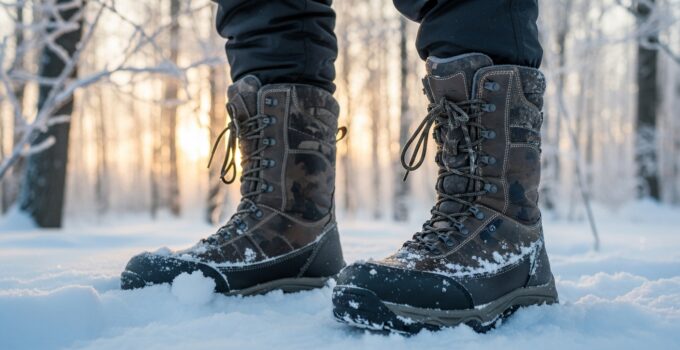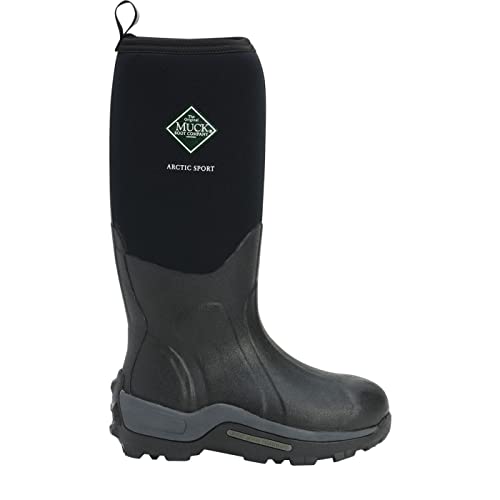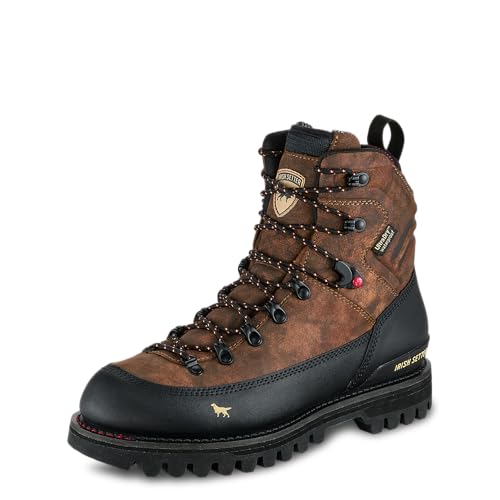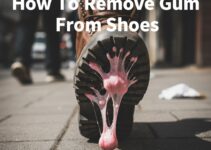Last Updated: November 11, 2025 | By: The BootsGuru Team
It’s 5 AM, it’s 20°F, and you just stepped in a hidden creek on the walk to your stand. Your hunt is over before it began—not because of the deer, but because your “waterproof” boots failed. Don’t let your gear be the reason you go home empty-handed.
Here’s the cold, hard truth: a standard hiking boot is too loud and not warm enough. A standard work boot is too heavy, clunky, and stinks like leather and oil. Hunting is a sport of specialized needs, and cold-weather hunting is the most demanding of all.








The “best hunting boot” doesn’t exist. The boot you need for a cold, stationary deer stand (insulated, scent-free rubber) is the total opposite of the boot you need for a high-mileage elk hunt (lightweight, supportive leather). As boot experts who’ve endured countless frozen-toe-mornings, we’re here to be your guide. This article breaks down the types of hunting boots, explains what insulation “grams” really mean, and reviews the top boots for your specific cold-weather hunt.
Quick Picks: Top 6 Cold Weather Hunting Boots (2025)
| Award | Boot Model | Insulation | Best For | Price |
|---|---|---|---|---|
| 🏆 Best Overall (Pac Boot) | Muck Boot Arctic Sport | Fleece + 5mm Neoprene | Scent-Free, All-Weather, Stand Hunting | $$$ |
| 🏔️ Best Mountain/Elk Boot | Kenetrek Mountain Extreme 400 | 400g (Active) | Rugged Terrain & Support | $$$$$ |
| 🌲 Best All-Around Leather | ||||
| 🥾 Best Active/Upland | Irish Setter Vaprtrek (800g) | 800g (Active) | Upland, Active Hunting, Lightweight | $$ |
| 🥶 Warmest (Arctic-Rated) | Baffin Impact | 8-Layer Liner (-148°F) | Extreme Cold, Ice Fishing, Stationary | $$$ |
| 💧 Best Scent-Free (Snug Fit) | LaCrosse AlphaBurly Pro (800g) | 800g (or 1600g) | Scent-Free, Walking to Stand | $$$ |
Hunting Boot 101: The 3 Main Types (Rubber vs. Leather vs. Upland)
Your hunt dictates your boot. Here are the three main categories and what they’re for:
1. Rubber (Pac) Boots (e.g., Muck, LaCrosse)
Pros: 100% Waterproof (perfect for swamps/creeks), and most importantly, 100% Scent-Free. Rubber doesn’t hold human odor, which is a massive advantage for deer hunting.
Cons: Less durable against sharp rocks or barbed wire, poor ankle support for mountains, and can be sweaty (less breathable).
Guru Verdict: The best choice for whitetail stand hunting, waterfowl, turkey hunting, and any very wet or muddy terrain.
2. Leather / Mountain Boots (e.g., Kenetrek, Irish Setter)
Pros: Maximum durability (resists rocks/brush), excellent ankle support for steep terrain, and great all-around traction. Generally more breathable than rubber.
Cons: Heavier, require a break-in period, not scent-free (leather holds odor), and must be regularly treated to maintain waterproofing.
Guru Verdict: The only choice for active, high-mileage mountain hunting (elk, sheep, goat) or rugged, uneven terrain.
3. Upland / Field Boots (e.g., Irish Setter Vaprtrek)
Pros: Lightweight (often feel like a sneaker), very comfortable for walking all day (10+ miles), and quiet on dry ground.
Cons: Less waterproof, minimal-to-moderate insulation, and less durable than a heavy-duty mountain boot.
Guru Verdict: The best boot for upland bird hunting (pheasant, quail, grouse) or any early-season, high-mileage hunt where you’re constantly moving.
Decoding Insulation: What Do “Grams” Really Mean?
The “g” (e.g., 800g) refers to the weight of Thinsulate™ (or equivalent) insulation per square meter. More grams = more warmth. But here’s the honest truth: an “active” rating is different from a “stationary” one.

hunting boot insulation grams 400g 800g 1200g explained
- Uninsulated (0g): For early season, active hunting in warm-to-cool climates.
- 200g – 400g (Active Insulation): This is the sweet spot for active, high-mileage hunting (like elk or upland). It keeps you warm while you’re moving, but you’ll get cold if you sit for hours.
- 800g – 1200g (Stationary Insulation): This is the “sweet spot” for deer stand hunting in typical cold weather (20°F to 40°F). It’s warm enough for sitting but not so hot that your feet will soak with sweat on the walk in.
- 1600g – 2400g+ (Arctic Insulation): For extreme cold (below 20°F / -6°C) and long, stationary sits. This is overkill for anything else—your feet will sweat profusely if you walk too far.
Detailed Reviews: Top Cold Weather Hunting Boots (2025)
🏆 1. Best Overall (Pac Boot): Muck Boot Arctic Sport
- This product is intended for severe wet conditions. Made with PFAS chemicals
- Rugged outsole with grip
- Shaft Circumference: 17in
- 100% Waterproof
- Fleece lining for warmth
The Honest Take: The Muck Boot Arctic Sport is a classic for a reason. It’s a no-fuss, 100% waterproof, and incredibly warm boot. The 5mm neoprene bootie (what scuba suits are made of) is a fantastic insulator on its own, but the added fleece lining makes it exceptionally warm for cold days in the stand (comfort rated down to -40°F). It’s a bit bulky for long walks, but the fit is comfortable and the sole has good, all-purpose grip. For all-around cold-weather hunting, especially stand hunting or wet conditions, it’s a reliable, scent-free choice.
Pros & Cons
| Pros | Cons |
|
|
Best For: Scent-free stand hunting, wet/muddy conditions, all-around cold weather use.
🏔️ 2. Best Mountain/Elk Boot: Kenetrek Mountain Extreme 400
- 10" tall leather uppers made from 2.8 mm full grain leather feature double and triple stitching throughout utilizing a one piece vamp construction with no seams down the tongue for comfort, abrasion resistance and additional moisture resistance. With care and maintenance the full grain leather will develop a patina of deep brown coloration featuring the scars of all your memorable hunts and hiking adventures until you consider them an old friend.
- The Kenetrek K-Talon Outsoles provide exceptional grip and traction with rigid support to keep you on your feet while traversing the most difficult terrain. The 7 mm nylon midsoles offer a solid foundation for unparalleled stability on the most uneven surfaces. This incredible level of support translates into reduced foot fatigue, increased ankle protection and the peace of mind knowing your boots won't let you down.
- We don't cut corners on quality. The boot hardware is not your typical "stamped metal" hardware you see on other boots but a high quality forged alloy that offers corrosion resistance, increased durability and swivels instead of breaking when placed under stress.
- Dry, comfortable feet have a direct impact on the success or failure of your hunting and hiking. Don't let one of your most memorable experiences be ruined by soaked, blistered feet. In order to avoid blisters it is crucial to keep as much moisture and humidity out of your boots as possible with Kenetrek's durable Windtex waterproof membrane. The Mountain Extreme also features the perfect amount of lightweight 400 gram Thinsulate insulation to keep you warm and dry.
- Scrambling up rough, rocky scree slopes, through thick brush and brambles and across fallen timber can do a number on your boots. The Kenetrek Mountain Extreme features a reinforced rubber sole guard on the lower portion of the boot for extra abrasion resistance from scrapes and scratch damage. It's a simple thing but goes a long way in protecting the life and longevity of your boots.
The Honest Take: This is a specialized, professional-grade tool for mountain hunting. It is not a comfort boot; it’s a support boot. The 2.8mm thick leather upper and ultra-rigid nylon shank create a rock-solid platform for side-hilling on steep, rocky terrain and packing out 100+ lbs of meat. The 400g of Thinsulate is the perfect “active” insulation—it keeps you warm while you’re moving without causing overheating. It requires a serious break-in period, but if you hunt elk, sheep, or goats in rugged terrain, this boot is a life-saving investment.
Pros & Cons
| Pros | Cons |
|
|
Best For: Elk, Sheep, or Goat hunting in rugged, steep mountains; prioritizing support over all else.
🌲 3. Best All-Around Leather: Irish Setter Elk Tracker 882 (600g)
- All-Day Performance: Nubuck leather upper with lace-to-toe fit, locking hook, and stretch collar allows a tighter fit to prevent discomfort. CuShin comfort tongue helps reduce pressure on your shin from the top of the boot tongue, and high-rebound ENERG material in the sole bounces back with every step to fight fatigue.
- Comfortable & Durable: A removable memory foam/EVA footbed creates underfoot comfort. Temperature-regulation is built into the neoprene lining with TempSens technology reacting to your body temperature and sweat level to keep you dry and comfortable, and Scentban scent control eliminates odors inside the boot.
- Tough Terrain Traction & Durability: Keep stability and traction with Vibram Bulls-Eye Air Bob Aggressive outsole with durable, long-lasting Megagrip compound and tread pattern to release mud and dirt for better traction. Armatec rubber rand provides abrasion resistance against debris, while leather gusset overlay helps prevent debris from getting into the boot.
- Waterproof Design: Nubuck leather is protected with UltraDry waterproof construction that combines a moisture management lining with waterproof components for dry, long-lasting comfort and performance.
- Resoleable Platform: The welted construction of the dual density sole platform prevents water intrusion and adds strength and durability to the boot making it long lasting. It allows the boot to be resoled to extend the life of the boot.
The Honest Take: The Elk Tracker is a legend for a reason. It’s the perfect “do-it-all” leather hunting boot that bridges the gap between a clunky pac boot and a rigid mountain boot. It combines a GORE-TEX waterproof liner, 600g of Thinsulate (a great all-purpose warmth level), and a durable, resolable Goodyear welt. The 12-inch height is fantastic for support and keeping snow out. It’s supportive enough for moderate mountains but comfortable enough for long walks on flat ground. A true, reliable workhorse.
Pros & Cons
| Pros | Cons |
|
|
Best For: All-around deer or elk hunting, varied terrain, hunters who want one durable leather boot.
🥾 4. Best Active/Upland: Irish Setter Vaprtrek (800g)
- Camouflage Leather: Connect deeper in the woodlands with Mossy Oak Country Roots camouflage patterned full grain leather with flex areas and ArmaTec heel protection for durable, flexible comfort.
- All-Day Performance: Polyurethane foam footbed for underfoot comfort, while ScentBan technology helps eliminate and resist odors. EnerG high-rebound sugarcane EVA midsole fight fatigue with every step. 400g PrimaLoft insulation keeps you extra warm from cold temperatures.
- Tough Terrain Traction: Keep stability and traction in the elements with the Rubber Hex Lite wrap-up outsole with multi directional lugs designed to grab the ground in every direction.
- Waterproof Construction: UltraDry waterproofing and cement construction keeps your feet dry for long-lasting comfort and performance.
- Lightweight Comfortability: Stability and ankle protect from padded ankle pod, while the Cushin comfort tongue and stretch collar cushions calves and achilles.
The Honest Take: If you’re an active hunter who walks 10+ miles a day (upland, spot-and-stalk) but still needs warmth, the Vaprtrek is a fantastic choice. It feels like an athletic hiker, not a clunky boot, thanks to its lightweight RPM sole technology. This model packs 800g of PrimaLoft® insulation and a waterproof membrane, making it surprisingly warm for its low weight. It’s the perfect boot for staying warm while moving, reducing fatigue significantly over a long day of chasing pheasants in the snow.
Pros & Cons
| Pros | Cons |
|
|
Best For: Upland bird hunting (pheasant, quail), spot-and-stalk, active hunters prioritizing light weight.
🥶 5. Warmest (Arctic-Rated): Baffin Impact
- Upper: Tall height, stylish leather and nylon upper with locking snow collar to protect from the elements, Low-impact and environmentally sustainable B-Tek Eco materials, Double buckle fastening for added security.
- Base: Arctic Rubber shell to provide lightweight flexibility, cold-resistance and resilience, EVA midsole for lightweight insulation and cushioning, Polar Rubber outsole for maximized grip and longevity of boot at cold temperatures.
- Removable Comfort-Fit multi-layer inner boot system featuring: Thermaplush soft, wicking layer for warmth, Form-fitting B-Tek Foam lining for comfort, Double B-Tek Heat lightweight, 4-channel hollow-fibre insulation for high-loft breathability in a broad range of temperatures.
- Vapourized Aluminum Membrane for energy reflection and heat regulation, PolyWool polyester wool blend for breathable warmth, Hydromax layering for improved moisture management, DiamondNet insulation for wind-resistant protection with a lightweight feel.
- Waffle-comb footbed designed to trap warm air and control odour, Double Aluminum insole returns heat and reflects cold for temperature regulation. Boots rated for polar conditions as low as -148 degrees.
The Honest Take: This is not a boot, it’s a portable furnace. With a temperature rating of -148°F (-100°C), the Baffin Impact is built for one thing: sitting perfectly still in the most extreme cold on Earth. The magic is its 8-layer removable foam liner that traps heat and wicks moisture. It is 100% waterproof and has a great snow-biting sole. It is way too bulky and warm for active hunting, but for sitting motionless in a deer stand in Canada or ice fishing, it is the warmest boot, period.
Pros & Cons
| Pros | Cons |
|
|
Best For: Extreme cold (sub-zero F), stationary hunting, ice fishing, snowmobiling.
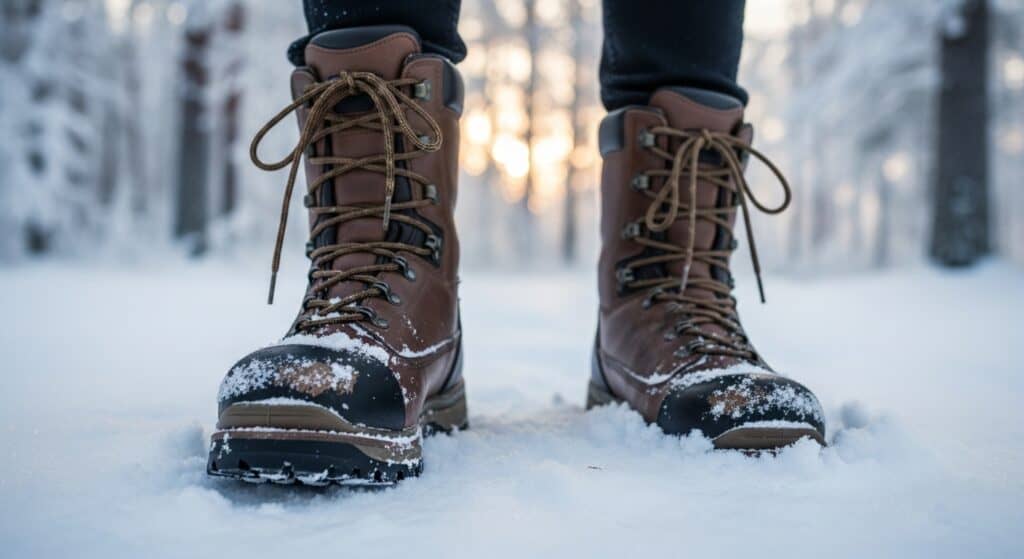
cold weather hunting boots
How to Care for Your Insulated Hunting Boots
Your expensive boots will die an early death if you neglect them. Follow these steps:
- Clean Them: Hose off rubber boots. Use a boot brush and proper leather cleaner on leather boots to remove mud and blood, which can degrade the materials.
- Dry Them (The Most Important Step): NEVER use a fire or radiator. High heat cracks rubber and destroys leather glues and GORE-TEX membranes. Always remove the insoles (and liners) and use a gentle boot dryer (low/no heat). This is non-negotiable.
- Store Them Correctly: Store rubber boots in a cool, dark place (UV rays from sunlight will crack the rubber). Store leather boots in a cool, dry place after conditioning them.
Frequently Asked Questions (FAQ)
Do I really need 1200g+ of insulation?
Only if you are sitting still for long periods (e.g., in a deer stand) in temperatures below freezing (32°F / 0°C). If you are actively hiking or walking, 1200g will be far too warm, and your feet will be soaked in sweat, which ironically makes you colder.
Why are rubber boots better for deer hunting?
Two words: Scent control. Rubber is non-porous and does not absorb or hold human odor. A whitetail deer can smell your leather boots from a long way off. Rubber boots (combined with scent-free spray) make you virtually invisible to their nose.
Are hunting boots worth it, or can I just use hiking boots?
They are absolutely worth it. A hiking boot is not insulated for stationary warmth, is not scent-free, and often lacks the rugged, off-trail ankle support of a true hunting boot. A hiking boot is built for a trail; a hunting boot is built for the woods.
How do I size hunting boots? (Do I size up?)
Yes, almost always. Plan on wearing thick wool or thermal socks. We recommend buying at least a half-size (1/2) up from your normal street shoe size. A tight boot restricts blood flow and makes your feet cold, regardless of insulation.
Conclusion: Match Your Boot to Your Hunt
Your boot is your most important hunting tool. But “best” is relative. The key is to stop looking for one boot to do everything and start matching your boot to your specific hunt.
Final Takeaway: For stand hunting, prioritize scent-free rubber and high insulation (800g+). For active mountain hunting, prioritize leather, ankle support, and durability (200g-400g). For fast-moving upland hunts, prioritize light weight and comfort.
For the best all-around “do-it-all” leather boot, you can’t go wrong with the Irish Setter Elk Tracker. But for most whitetail stand hunters, the Muck Boot Arctic Sport is an industry-standard for a reason. Choose the right tool for the job, and stay in the field longer.

